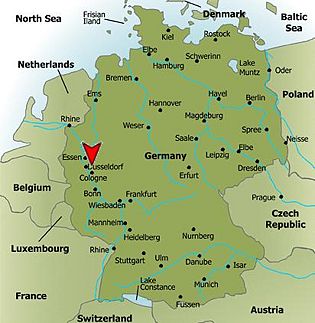Neanderthal
- This article is currently being developed as part of a student project involving an Anthropology course at University of Colorado at Boulder. If you are not involved with this project, please refrain from further developing this article until otherwise noted. Thank you.
The Neanderthals[1] are an extinct nonmodern hominid that come chronologically extremely close to the modern era, becoming extinct less than 30,000 years ago.
Homo neanderthalensis or Homo sapiens neanderthalensis? As the most well known archaic Homo sapien, it is often questioned whether they are directly ancestral to fully modern Homo sapiens or merely an extinct cousin. They are very well adapted to cold environments, with shortened forearms and lower legs to reduce surface area resulting in less lost body heat. They were indisputably big game hunters with a high reliance on meat in their diet. The Mousterian tool industry is associated with Neanderthals. Evidence supports the earliest examples of compassion and ritual come with Neanderthals.
Discovery
Neander Valley, in German literally "Neandertal", in the German Federal State of North Rhine-Westphalia, where the river Düssel flows to meet the Rhine, is where the first fossil to be recognized as a different kind of human was discovered. In August of 1856, miners in search of limestone blasted open the entrance to a small cave, Feldhofer Cave (also called Feldhofer grotto) where a skullcap was originally discovered. The fossil displayed a long skull joining with very pronounced brow ridges. Close by, the miners came across some additional bones including two femora, five arm bones, part of the left ilium, portions of a scapula and multiple ribs. The fossils were set aside for the eventual examination by a local school teacher and amateur natural historian, Johann Fuhlrott.
Fuhlrott recognized the importance of the bone and brought them to the professor of anatomy at the University of Bonn, Hermann Schaaffhausen. After much examination, the pair presented their discovery of the Neanderthaler ("Neanderthal Man") in June of 1857 where they highlighted the inferred antiquity of the specimen. Unable to accurately describe the unusual cranial characteristics of the Neanderthaler, Schaaffhausen concluded that this individual must have belonged to an ancient aboriginal tribe residing in Germany before modern inhabitation, implying it was simply an inferior version of our own species.
This explanation, along with the emphasis Schaaffhausen and Fuhlrott were placing on the great antiquity of the Neanderthaler, was not well recieved in the scientific community. Many opposing views surfaced, the most well recieved by a leading German scientist Rudolf Virchow. Virchow argued that the abnormal appearance of the skull was due to pathology, it was simply a particularly unfortunate affliction this individual suffered and there is no chance it was a different type of human. After the discovery of like fossils in the coming years, and acknowledgment of previously discovered fossils belonging to the same species, was Homo neanderthalensis accepted as an ancient variation of human.
Neanderthals were first acknowledged as a skull and other various bones were found by miners at a limestone quarry in Neandertal, Germany. The Neander Valley of the river Düssel in the German Federal State of North Rhine-Westphalia, belonging to the small towns of Erkrath and Mettmann. The partial skeleton was found in Feldhofer Cave consisting of a skull cap, two femora, five arm bones, part of the left ilium, portions of a scapula, and ribs. The material was turned over to an anatomy professor at the University of Bonn, and in accordance with Johann Karl Fuhlrott, Neanderthal 1 was announced in 1857.
Morphology
Cranial morphology
Skeletal morphology
Habitat
Culture
Mousterian tradition
Subsistence
Compassion and community
Symbolism, rituals and burials
Sites and significant fossils
Notes
- ↑ Also spelled Neandertal. The original German spelling includes an h but is pronounced as if no h is present.
References
Kenneth L. Feder The Past in Perspective: An Introduction to Human Prehistory 4th ed. McGraw-Hill, 2007.
